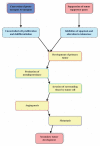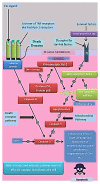Role of Pentacyclic Triterpenoids in Chemoprevention and Anticancer Treatment: An Overview on Targets and Underling Mechanisms
- PMID: 31338244
- PMCID: PMC6645347
- DOI: 10.3831/KPI.201.22.007
Role of Pentacyclic Triterpenoids in Chemoprevention and Anticancer Treatment: An Overview on Targets and Underling Mechanisms
Abstract
The incidences of cancer are continuously increasing worldwide, affecting life of millions of people. Several factors associated with the internal and external environment are responsible for this deadly disease. The key internal determinants like abnormal hormonal regulation, genetic mutations and external determinants such as lifestyle and occupational factors enhances onset of cancer. From the ancient time, plants were remained as the most trusted source of medicine for the treatment of diverse disease conditions. Extensive studies have been performed for the discovery of effective anticancer agent from the plant and still it is going on. Pentacyclic triterpenoids are biologically active phytochemicals having a different range of activities such as anti-inflammatory, hepatoprotective, anti-hypertensive, antiulcerogenic and anti-tumor. These compounds generally contain ursane, oleanane, lupane and friedelane as a chief skeleton of pentacyclic triterpenoids which are generally present in higher plants. Isoprene unit, phytochemical, with good antitumor/anticancer activity is required for the biosynthesis of pentacyclic triterpenoids. Mechanisms such as cytotoxicity, DNA polymerase inhibition, regulation of apoptosis, change in signal transductions, interfere with angiogenesis and dedifferentiation, antiproliferative activity and metastasis inhibition are might be responsible for their anticancer effect. Present review spotlights diverse targets, mechanisms and pathways of pentacyclic triterpenoids responsible for anticancer effect.
Keywords: anti-angiogenic; antiproliferative; apoptosis; cancer; isoprene; pentacyclic triterpenoids.
Conflict of interest statement
Conflict of interest There is no conflict of interest and disclosures associated with the manuscript.
Figures




Similar articles
-
Nanoformulations for Delivery of Pentacyclic Triterpenoids in Anticancer Therapies.Molecules. 2021 Mar 21;26(6):1764. doi: 10.3390/molecules26061764. Molecules. 2021. PMID: 33801096 Free PMC article. Review.
-
Bioactive Pentacyclic Triterpenes Trigger Multiple Signalling Pathways for Selective Apoptosis Leading to Anticancer Efficacy: Recent Updates and Future Perspectives.Curr Protein Pept Sci. 2023;24(10):820-842. doi: 10.2174/1389203724666230418123409. Curr Protein Pept Sci. 2023. PMID: 37073661 Review.
-
Unveiling the pharmacological potential of plant triterpenoids in breast cancer management: an updated review.Naunyn Schmiedebergs Arch Pharmacol. 2024 Aug;397(8):5571-5596. doi: 10.1007/s00210-024-03054-2. Epub 2024 Apr 2. Naunyn Schmiedebergs Arch Pharmacol. 2024. PMID: 38563878 Free PMC article. Review.
-
Pentacyclic triterpenoids and their saponins with apoptosis-inducing activity.Curr Top Med Chem. 2009;9(16):1581-96. doi: 10.2174/156802609789909821. Curr Top Med Chem. 2009. PMID: 19903161 Review.
-
Recent Advances in Antiviral Activities of Triterpenoids.Pharmaceuticals (Basel). 2022 Sep 21;15(10):1169. doi: 10.3390/ph15101169. Pharmaceuticals (Basel). 2022. PMID: 36297280 Free PMC article. Review.
Cited by
-
Nanoformulations for Delivery of Pentacyclic Triterpenoids in Anticancer Therapies.Molecules. 2021 Mar 21;26(6):1764. doi: 10.3390/molecules26061764. Molecules. 2021. PMID: 33801096 Free PMC article. Review.
-
Synthesis, Pharmacological Properties, and Potential Molecular Mechanisms of Antitumor Activity of Betulin and Its Derivatives in Gastrointestinal Cancers.Pharmaceutics. 2023 Dec 13;15(12):2768. doi: 10.3390/pharmaceutics15122768. Pharmaceutics. 2023. PMID: 38140110 Free PMC article. Review.
-
A comprehensive review of Tripterygium wilfordii hook. f. in the treatment of rheumatic and autoimmune diseases: Bioactive compounds, mechanisms of action, and future directions.Front Pharmacol. 2023 Nov 1;14:1282610. doi: 10.3389/fphar.2023.1282610. eCollection 2023. Front Pharmacol. 2023. PMID: 38027004 Free PMC article. Review.
-
Fractionation and Characterization of Triterpenoids from Vaccinium vitis-idaea L. Cuticular Waxes and Their Potential as Anticancer Agents.Antioxidants (Basel). 2023 Feb 12;12(2):465. doi: 10.3390/antiox12020465. Antioxidants (Basel). 2023. PMID: 36830023 Free PMC article.
-
Unraveling the Peculiar Features of Mitochondrial Metabolism and Dynamics in Prostate Cancer.Cancers (Basel). 2023 Feb 13;15(4):1192. doi: 10.3390/cancers15041192. Cancers (Basel). 2023. PMID: 36831534 Free PMC article. Review.
References
-
- Dhanamani M, Devi SL, Kannan S. Ethnomedicinal plants for cancer therapy - a review. Hygeia JD Med. 2011;3:1–10.
-
- Rang HP, Ritter JM, Flower RJ. Rang and Dale’s Pharmacology: With student consult online access: Elsevier Health Sciences. 7th edition. Churchill Livingstone; Edinburgh: 2012.
Publication types
LinkOut - more resources
Full Text Sources
